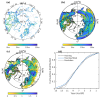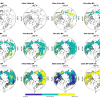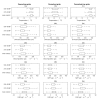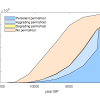Description
Northern peatlands are a large C stock and often act as a C sink, but are susceptible to climate warming. To understand the role of peatlands in the global carbon-climate feedback, it is necessary to accurately quantify their C stock changes and decomposition. In this study, a process-based model, the Peatland Terrestrial Ecosystem Model, is used to simulate pan-Arctic peatland C dynamics from 15ka BP to 1990. To improve the accuracy of the simulation, grid-specific water run-on and run-off processes were considered, four different pan-Arctic peatland distribution datasets were used, and a spatially-explicit peat basal date dataset was developed using a neural network approach. The model was calibrated against 2055 peat thickness observations and the parameters were interpolated to the pan-Arctic region. Using the model, we estimate that, in 1990, the pan-Arctic peatlands soil C stock is 396-421 Pg C, and the Holocene average C accumulation rate was 22.9 g C∙m-2 yr-1. Our estimated peat permafrost development history generally agrees with multi-proxy-based paleo-climate datasets and core-derived permafrost areal dynamics. During 500 BP to 1990, the pan-Arctic region went through the Little Ice Age and Anthropocene warming. Under Anthropocene warming, in the freeze-thaw and permafrost-free regions, the peat C accumulation rate decreased, but it increased in permafrost regions. The project's outcome helps understanding the potential peatland responses to future climate changes.
Cite this work
Researchers should cite this work as follows:
- Zhao, B.; Zhuang, Q.; Frolking, S. (2022). Modeling carbon accumulation and greenhouse gas emissions of northern peatlands since the Holocene. Purdue University Research Repository. doi:10.4231/6647-C769



